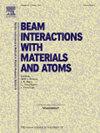Novel energy-filtered implantation technique for field stop formation in silicon power devices
IF 1.4
3区 物理与天体物理
Q3 INSTRUMENTS & INSTRUMENTATION
Nuclear Instruments & Methods in Physics Research Section B-beam Interactions With Materials and Atoms
Pub Date : 2025-05-21
DOI:10.1016/j.nimb.2025.165715
引用次数: 0
Abstract
Insulated Gate Bipolar Transistors (IGBTs) power devices require high blocking capability, low on-resistance as well as adaptable switching behaviour. The technique presented in this work aims to realize continuous deep () n-type profiles as field stop structures in high voltage silicon IGBTs (1200 V) to adjust the switching capability. Hydrogen-related donor (HD) defect complexes perform as n-type dopants in single crystalline silicon. Up to now, these IGBT field stop profiles are generated using multiple high energy (up to ) implantation steps. In contrast, we achieve continuous deep HD profiles in a single implantation step by inserting a micro-patterned silicon membrane (energy filter) into the primary ion beam at an energy of to provide a beam with a broad customized energy distribution. In this work, we investigate how filter structure, implanted fluence (from cm−2 to cm−2) and annealing conditions affect the depth distribution of HD defect complexes. We found that the electrically active dose divided by the implanted fluence before the energy filter, depends on the pattern type of the membrane (long grooves or squares), the implanted fluence and the annealing hold temperature (C to C).
用于硅功率器件场阻挡形成的新型能量滤波注入技术
绝缘栅双极晶体管(igbt)功率器件要求高阻断能力,低导通电阻以及自适应开关行为。这项工作的目的是在高压硅igbt (1200 V)中实现连续深(>40μm) n型轮廓作为场停止结构,以调节开关能力。氢相关供体(HD)缺陷配合物在单晶硅中作为n型掺杂剂。到目前为止,这些IGBT场停止轮廓是通过多个高能(高达2MeV)注入步骤产生的。相比之下,我们通过在2.5MeV能量的主离子束中插入微图案硅膜(能量过滤器),在一次注入步骤中获得连续的深高清轮廓,从而提供具有广泛定制能量分布的光束。在这项工作中,我们研究了过滤器结构,注入通量Φ(从1013 cm−2到5×1015 cm−2)和退火条件如何影响HD缺陷配合物的深度分布。我们发现,电活性剂量除以能量过滤器前注入的通量,取决于膜的图案类型(长槽或方形)、注入的通量和退火保持温度(320°C至420°C)。
本文章由计算机程序翻译,如有差异,请以英文原文为准。
求助全文
约1分钟内获得全文
求助全文
来源期刊
CiteScore
2.80
自引率
7.70%
发文量
231
审稿时长
1.9 months
期刊介绍:
Section B of Nuclear Instruments and Methods in Physics Research covers all aspects of the interaction of energetic beams with atoms, molecules and aggregate forms of matter. This includes ion beam analysis and ion beam modification of materials as well as basic data of importance for these studies. Topics of general interest include: atomic collisions in solids, particle channelling, all aspects of collision cascades, the modification of materials by energetic beams, ion implantation, irradiation - induced changes in materials, the physics and chemistry of beam interactions and the analysis of materials by all forms of energetic radiation. Modification by ion, laser and electron beams for the study of electronic materials, metals, ceramics, insulators, polymers and other important and new materials systems are included. Related studies, such as the application of ion beam analysis to biological, archaeological and geological samples as well as applications to solve problems in planetary science are also welcome. Energetic beams of interest include atomic and molecular ions, neutrons, positrons and muons, plasmas directed at surfaces, electron and photon beams, including laser treated surfaces and studies of solids by photon radiation from rotating anodes, synchrotrons, etc. In addition, the interaction between various forms of radiation and radiation-induced deposition processes are relevant.

 求助内容:
求助内容: 应助结果提醒方式:
应助结果提醒方式:


